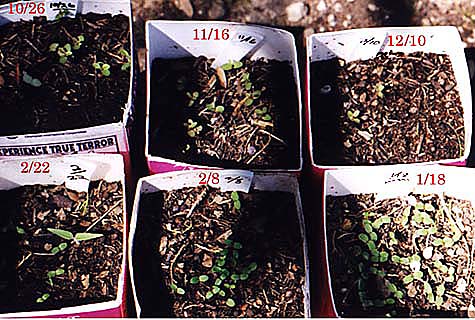

Planting in containers avoids some of the problems I have had with armadillos, pillbugs, and other pests, when I planted directly into the ground. Armadillos have destroyed most of my attempts to plant into the ground in more arid areas where insect pests are unlikely to be a problem.

Planting in 1/2 gal. paper milk cartons seems to work. The top part (that folds to a 'triangle') needs to be cut away, leaving a simple box. The bottom must be cut to provide drainage. I use an old beer can opener that makes a 1/2 inch triangular hole, 2 holes on each side. The resulting tab must be cut off or it will want to fold back into place.
I put c. 2 inches of course sand (from our creek) in the bottom, then loose soil that will drain well, topped by several inches of the juniper mulch from under a cedar tree. I spoon the seed onto the surface of this mulch layer. I don't otherwise cover them.
To keep the milk cartons off the ground and in a stable position I place each carton in one of those common 1-gal. plastic pots. The plastic of the pot helps, but will not prevent termites, slugs, pill bugs, etc. from getting at the milk carton; so I put a single flat rock to separate the carton from the bottom of the pot/surface of the ground. This will also keep the bottom of the carton from decomposing too soon. Finally, a few well-placed rocks along the sides of the pot keep the carton in a stable upright position. The one drawback of milk cartons is that termites love them, and once they attack the carton they will eventually devour any roots in the carton.
In 2006 I used narrow but deep cone-shaped pots held off the ground in a rack with some success. [Shown below]
Germination, March 30, 2006 |
Detail from area in red on left. |
|---|
The young seedlings are quite cold hardy — none have ever died from a hard freeze here in Central Texas. I did plant indoors once and got more seedlings, but most of them damped off. An outdoor start produces more robust seedlings (and does not foster the fungi, bacteria and other tiny critters that attacked my indoor seedlings). Placing the seedlings in a sheltered location (if not in hot sun) might be good.
Once the seeds have been planted, I water the seeds (preferably with rain water or creek water) only about once a week (if it doesn't otherwise rain).
The seedlings also seem to be quite drought hardy. I must admit that I have never followed the careful instructions for watering given in various handbooks for native plant nurseries. I sprinkle water from a can. Hot, dry summer weather does not seem to be a factor. (Bear in mind that full sun in a black nursery pot will create killing temperatures.)
My experience would not seem to support the advice given by Wasowski (1988) that "seedlings are susceptible to black spot and damping off. It needs five years to get established, and even then it should get supplemental watering." Plants that survive the first year don't require extra water. I have, of course, avoided pushing growth with extra water or fertilizers in my hill country setting. [My strategy is to start with large numbers - the seeds germinate in abundance - and expect to lose a high percentage. Damping, however, occurred only with seeds germinated indoors.]
Once the plants have a good set of true leaves, perhaps in late summer or early fall, the final step is to put the entire milk carton into the ground without in any way disturbing the roots inside. If the carton contains several plants, just plant the whole thing and let natural selection do the rest. It is best to cut away the top edge of the carton, so that the carton is flush with the surface of the soil. Even a very small seedling only several weeks old may have a root 2-4 inches long. Attempting to separate them out or to remove the carton isn't worth the risk.